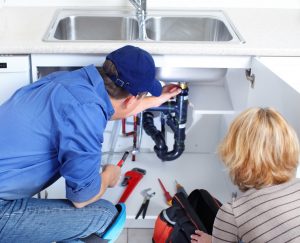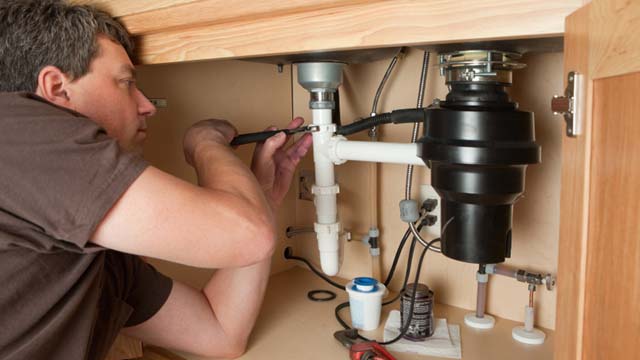Your Definitive Guide to Fixing a Leaky Waste Disposal Unit
Your Definitive Guide to Fixing a Leaky Waste Disposal Unit
Blog Article
How do you really feel in relation to Why Is ?

Garbage disposals are necessary kitchen area appliances that aid in taking care of food waste effectively. Nonetheless, a leaking garbage disposal can be a frustrating and unpleasant problem to deal with. The good news is, lots of leakages can be taken care of conveniently with a few straightforward actions. In this article, we will discuss exactly how to fix a dripping garbage disposal successfully.
Introduction
Waste disposal unit are set up under kitchen sinks and are created to shred food waste into smaller sized items, enabling it to pass through the pipes system quickly. While these tools are normally trusted, leaks can take place over time because of damage, loose connections, or damages to the unit.
Common Root Causes Of Leakages in Trash Disposals
Worn Seals and Gaskets
Seals and gaskets play an essential role in preventing water from dripping out of the waste disposal unit. Gradually, these elements can wear away, causing leakages around the disposal device.
Loose Links
The links between the waste disposal unit and the plumbing system can become loosened with time, causing water to leakage out during procedure.
Cracks or Openings in the Disposal Device
Physical damage to the waste disposal unit, such as splits or openings in the housing, can also result in leakages.
Identifying the Resource of the Leak
Prior to attempting to repair a leaking waste disposal unit, it is essential to determine the source of the leak. This can generally be done via visual examination or by carrying out basic tests.
Visual Assessment
Evaluate the waste disposal unit system very carefully for any type of indications of water leak. Pay attention to locations around seals, gaskets, and connection factors.
Testing for Leaks
One means to test for leaks is by running water with the disposal system and looking for any kind of visible signs of leakage.
Devices and Products Needed for Dealing With a Leaking Waste Disposal Unit
Before beginning the repair work process, collect the needed tools and products, including a screwdriver, adjustable wrench, plumber's putty, substitute seals or gaskets, and epoxy or patching product for repairing cracks or openings.
Step-by-Step Guide to Repairing a Dripping Garbage Disposal
Shut off the Power
Before trying any repair work, ensure that the power to the garbage disposal system is switched off to prevent the risk of electrical shock.
Find the Leak
Recognize the precise area of the leak and establish the cause.
Tighten Connections
Use a wrench to tighten any type of loose links in between the disposal device and the plumbing system.
Change Seals or Gaskets
If the leakage is due to used seals or gaskets, remove the old components and change them with brand-new ones.
Patching Splits or Holes
For splits or openings in the disposal system, use epoxy or a suitable patching product to seal the broken location.
Examining the Waste Disposal Unit After Fixing
Once the repair is full, examine the garbage disposal by running water via it to guarantee that the leakage has been settled.
Preventive Maintenance Tips to Stay Clear Of Future Leakages
To stop future leakages, it is essential to carry out routine upkeep on your waste disposal unit. This includes keeping it tidy, preventing placing non-food items or hard items down the disposal, and periodically looking for leakages or various other problems.
Verdict
To conclude, taking care of a leaking waste disposal unit is a reasonably uncomplicated process that can be finished with basic tools and products. By adhering to the steps outlined in this short article and practicing precautionary maintenance, you can keep your garbage disposal in good working problem and avoid pricey fixings in the future.
What to Do About a Leaking Garbage Disposal
A leaking garbage disposal often goes unnoticed until you confront a sopping cabinet, a foul-smelling puddle, or an audible drip-drip-drip from the unit. The fix can be frustrating, too, because the leak can stem from a number of components in the system. Fortunately, with a little sleuthing, you can zero in on the leak and—depending on the exact location—stop the icky oozing and repair the component that caused it. Worst case scenario, if it turns out that the garbage disposal must be replaced, installing a new one is a reasonable do-it-yourself task for those with basic plumbing skills. Read on to keep the cash you’d otherwise hand over to a pro.
Prepare to find the leak
Prior to testing the garbage disposal for leaks, unplug it at the wall outlet and turn off the power from the breaker box to prevent electrical shock. Then insert a watertight sink stopper into your sink drain and wipe the unit dry with a clean cloth. In any handy container, mix a few drops of food coloring into a few cups of water, and pour the dyed water onto the sink stopper to help you locate the leak.
Investigate the source
the top, where the disposal meets the sink drain the side, where the dishwasher hose or main drain pipe connects to the disposal or the bottom of the unit Inspect each of these locations while gliding a light-colored rag over the unit; the dyed water will readily show on the rag and reveal the location of the leak. If a leak isn’t immediately apparent, remove the sink stopper and pour a few more cups of dyed water down the sink drain, then check for leaks again. Leaks near the top of the unit are more likely to show themselves while the sink is plugged, while side and bottom leaks are more noticeable while the sink is unplugged.
The metal sink flange that sits directly inside the sink drain is typically sealed around the top with plumber’s putty (a clay-like sealant) and then secured from under the sink with bolts. If the plumber’s putty deteriorates, or the bolts loosen, the flange can no longer form a watertight seal between the sink drain and the disposal—which could cause a leak at the top of the unit.
To reseal the leaky flange, you must first detach the garbage disposal. Start by loosening the screws securing the main drain pipe to the disposal, then loosen the screws in the metal clamp securing the dishwasher hose to the disposal and detach the drain pipe and dishwasher hose from the disposal. Loosen the screws in the mounting ring that connects the disposal to the metal mounting assembly beneath the sink, then pull down the disposal and carefully set it on a clean, dry surface. Loosen the bolts in the mounting assembly with a wrench, then pull down the mounting assembly and set it near the disposal.

As a keen person who reads on How to fix a pretty consistent leak from my garbage disposal, I imagined sharing that article post was mandatory. Liked our blog posting? Please share it. Help someone else find it. I am grateful for your time. Please check up our website back soon.
Book Services Report this page